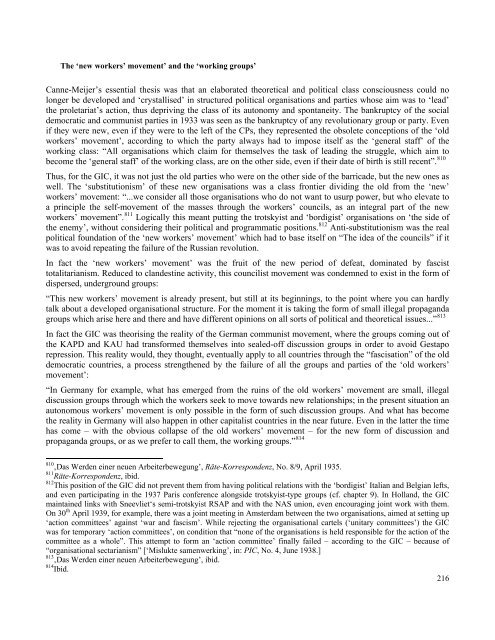The German-Dutch Communist Left - Libcom
The German-Dutch Communist Left - Libcom
The German-Dutch Communist Left - Libcom
Create successful ePaper yourself
Turn your PDF publications into a flip-book with our unique Google optimized e-Paper software.
<strong>The</strong> ‘new workers’ movement’ and the ‘working groups’<br />
Canne-Meijer’s essential thesis was that an elaborated theoretical and political class consciousness could no<br />
longer be developed and ‘crystallised’ in structured political organisations and parties whose aim was to ‘lead’<br />
the proletariat’s action, thus depriving the class of its autonomy and spontaneity. <strong>The</strong> bankruptcy of the social<br />
democratic and communist parties in 1933 was seen as the bankruptcy of any revolutionary group or party. Even<br />
if they were new, even if they were to the left of the CPs, they represented the obsolete conceptions of the ‘old<br />
workers’ movement’, according to which the party always had to impose itself as the ‘general staff’ of the<br />
working class: “All organisations which claim for themselves the task of leading the struggle, which aim to<br />
become the ‘general staff’ of the working class, are on the other side, even if their date of birth is still recent”. 810<br />
Thus, for the GIC, it was not just the old parties who were on the other side of the barricade, but the new ones as<br />
well. <strong>The</strong> ‘substitutionism’ of these new organisations was a class frontier dividing the old from the ‘new’<br />
workers’ movement: “...we consider all those organisations who do not want to usurp power, but who elevate to<br />
a principle the self-movement of the masses through the workers’ councils, as an integral part of the new<br />
workers’ movement”. 811 Logically this meant putting the trotskyist and ‘bordigist’ organisations on ‘the side of<br />
the enemy’, without considering their political and programmatic positions. 812 Anti-substitutionism was the real<br />
political foundation of the ‘new workers’ movement’ which had to base itself on “<strong>The</strong> idea of the councils” if it<br />
was to avoid repeating the failure of the Russian revolution.<br />
In fact the ‘new workers’ movement’ was the fruit of the new period of defeat, dominated by fascist<br />
totalitarianism. Reduced to clandestine activity, this councilist movement was condemned to exist in the form of<br />
dispersed, underground groups:<br />
“This new workers’ movement is already present, but still at its beginnings, to the point where you can hardly<br />
talk about a developed organisational structure. For the moment it is taking the form of small illegal propaganda<br />
groups which arise here and there and have different opinions on all sorts of political and theoretical issues...” 813<br />
In fact the GIC was theorising the reality of the <strong>German</strong> communist movement, where the groups coming out of<br />
the KAPD and KAU had transformed themselves into sealed-off discussion groups in order to avoid Gestapo<br />
repression. This reality would, they thought, eventually apply to all countries through the “fascisation” of the old<br />
democratic countries, a process strengthened by the failure of all the groups and parties of the ‘old workers’<br />
movement’:<br />
“In <strong>German</strong>y for example, what has emerged from the ruins of the old workers’ movement are small, illegal<br />
discussion groups through which the workers seek to move towards new relationships; in the present situation an<br />
autonomous workers’ movement is only possible in the form of such discussion groups. And what has become<br />
the reality in <strong>German</strong>y will also happen in other capitalist countries in the near future. Even in the latter the time<br />
has come – with the obvious collapse of the old workers’ movement – for the new form of discussion and<br />
propaganda groups, or as we prefer to call them, the working groups.” 814<br />
810 ‚Das Werden einer neuen Arbeiterbewegung’, Räte-Korrespondenz, No. 8/9, April 1935.<br />
811 Räte-Korrespondenz, ibid.<br />
812 This position of the GIC did not prevent them from having political relations with the ‘bordigist’ Italian and Belgian lefts,<br />
and even participating in the 1937 Paris conference alongside trotskyist-type groups (cf. chapter 9). In Holland, the GIC<br />
maintained links with Sneevliet‘s semi-trotskyist RSAP and with the NAS union, even encouraging joint work with them.<br />
On 30 th April 1939, for example, there was a joint meeting in Amsterdam between the two organisations, aimed at setting up<br />
‘action committees’ against ‘war and fascism’. While rejecting the organisational cartels (‘unitary committees’) the GIC<br />
was for temporary ‘action committees’, on condition that “none of the organisations is held responsible for the action of the<br />
committee as a whole”. This attempt to form an ‘action committee’ finally failed – according to the GIC – because of<br />
“organisational sectarianism” [‘Mislukte samenwerking’, in: PIC, No. 4, June 1938.]<br />
813 ‚Das Werden einer neuen Arbeiterbewegung’, ibid.<br />
814 Ibid.<br />
216
















